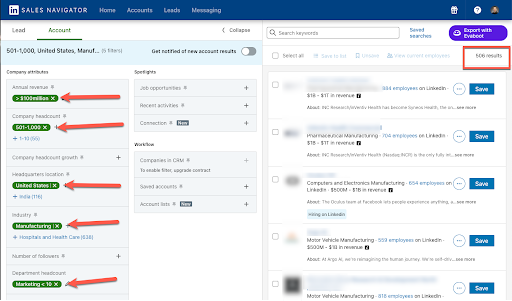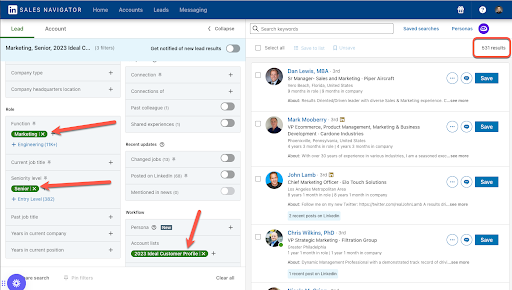“To be everywhere is to be nowhere,” goes the old saying. If you’ve had a sales or marketing effort fall short, you may have had an “everywhere” campaign that targeted everyone but generated no valuable responses. Trying to send a message to everyone weakens the message sent by marketing, and can lead to bad leads for the sales team.
Account-based marketing (ABM) is the answer to this problem, and a great way to align sales and marketing efforts.
ABM is the practice of narrowing your target audience so that you can create more personalized messaging. As a result, your messaging is stronger, and the sales team has better leads.
In this post, we’re going to explore ABM and provide tips on how to develop your Ideal Customer Profile.
Before you read more, here’s a quick video:
Manufacturers can use ABM to align sales and marketing
ABM gets rid of the idea of sales and marketing being separate teams. Separate teams have different conversations and rarely are on the same page as a result.
“My number is your number.” (Source: The Book on Account Based Marketing). This quote brings sales and marketing teams together to focus only on revenue generation. This approach eliminates silos of sales and marketing and allows them to pull in the same direction.
One team. One goal. Everyone plays a role in increasing revenue.
Finding the key components of your ICP
Account-based marketing revolves around the idea of an ICP—the Ideal Customer Profile.
An Ideal Customer Profile is a list of all characteristics of the customers that work best with your company. The more defined a customer profile is, the more effective it will be. Several key characteristics include annual revenue, employee count, location, and annual marketing budget.
An ABM campaign is not possible without a clearly defined ICP for one simple reason: How can you speak to someone’s needs if you don’t know what their needs are? In spite of this, marketing campaigns are run every day without any knowledge of the target audience.
ICPs are determined through analysis of any number of data categories, including:
- Industry
- Location
- Revenue
- Number of employees
- Online activity
The more detail, the more finely tuned an ICP is, and the more effective it will be. For example, Thomson Reuters narrowed their leads list down to the top 250 accounts (down from several thousand) and it helped deliver win rates of 75-95% (Source: ABM is B2B).
Talk to your people so you can build a great list
The act of building an ICP is the first step in uniting sales and marketing efforts. The characteristics of the ICP require input from both departments.
Building an effective ICP may require an uncomfortable conversation between the sales and marketing teams. Differences in priorities are exposed, and tensions may rise. This is what you want. Only when all priorities are publicized can meaningful change take place.
In the book ABM is B2B by Sangram Vajre and Eric Spett, the authors point to the helpful example of Pramata, a company specializing in saving B2B clients money. Prior to launching an ABM pilot program, the company discovered that 70% of leads were non-target accounts.
Every call the sales team makes to accounts that aren’t a good fit is a waste of time and money, and it hurts morale.
Remind your sales and marketing teams of stats like this as you bring them together to build the list.
Be prepared for uncomfortable conversations
During your team discussions, you’ll want to thoroughly review your sales and marketing initiatives. All details surrounding strategies will need to be voiced so that everyone can comprehend what works and what does not.
Avoid the blame game and be conscious of everyone’s feelings. Also, continually remind everyone of the common goal you’re all working toward: more revenue.
Both teams will need to walk away with a thorough understanding of their target market. A seamless transition from marketing to sales not only looks better to the customer but also brings the teams together.
Identify key similarities among your top customers
When determining an ICP, it’s helpful to analyze a firm’s current customers. For example, if the company has 100 total customers:
- Who are the top 5–10 customers in terms of how much value they bring to the firm?
- How do they behave and how is it different from the rest of the customers?
- Who is the decision maker?
- How big is the company?
Look for common threads among your top performers. For example, with Winbound, we help manufacturers with small or even nonexistent marketing departments.
When we search for sales and marketing leaders, we also search to see if they are surrounded by a marketing team. If they are not, we know they are a good fit.
Know what stage of growth your top customers are in
One extremely important characteristic to consider when forming an ABM strategy is the company’s growth stage:
- Are they in a mature phase?
- Are they trying to expand?
- Which growth phase presents the most opportunities for your firm’s services?
Identifying the growth stage that aligns most closely with your business helps narrow your ICP list.
Leveraging LinkedIn Sales Navigator to build an ICP list
The next step is to build the list itself. To create the list, LinkedIn Sales Navigator is an excellent resource to use to access the data you’ll need. It will allow you to build a list of both companies who fit your ICP description and the individuals at those companies whom you would like to speak to.*
*Conditional – employees are only able to be found if they have profiles on LinkedIn
To find the companies you are looking for, you’ll use the Accounts feature in Sales Navigator.
For example, say you would like to target manufacturing firms that have:
- More than $100 million in annual revenue
- 501-1000 employees, are located in the United States
- A marketing team of fewer than 10 people
You’ll click on the ‘Account filters’ button and enter the data accordingly.


This search turned up 506 companies. Now you will save them to a list so you can revisit them. Click on the ‘Save’ button to the right of the company’s name to save that individual company to your list. This works best if you only want a handful of companies on your list.
If you are adding every company that turns up in the results, click on ‘Select All,’ and it will allow you to add every company displayed on the page you are viewing. The results display 25 companies per page, and you’ll click to different pages with the ‘Next Page’ button at the bottom of the screen.
Once you have added the companies you wish to have in your list, it is time to determine the actual people you will be reaching out to. It will be up to you to determine how specific you want to get in your search. For this example, let’s say you are looking for Senior Level employees in Marketing.
VERY IMPORTANT: Ensure you select the account list you just created in the Account List option. By doing this, Sales Navigator will only search the companies you have already determined to be good fits.


Once this search is run, you’ve now identified 531 qualified leads to put on your Ideal Customer Profile leads list. To add them to the list, click the ‘Select All’ button, and then the ‘Add to List’ button. Sales Navigator will give you the option to create a new leads list.
By the time you are done, you will have created two new resources for your team to put to use: a list of companies who fit the profile of your ideal customer, and a list of contacts at those companies to reach out to. More importantly, you’ve saved yourself hours of research.
Sales Navigator allows you to save your work in lists, which are then able to be easily accessed when it comes time to apply the data to the ABM strategy.
Build your ICP today
By using ABM, manufacturers (and companies in every industry) can eliminate the days of smiling and dialing, shooting in the dark, and hoping blindly for success.
Your ICP is your starting point. Bring your sales and marketing teams together to identify the top customers that are of value to the company. Then build your ICP list, using tools like LinkedIn Sales Navigator.
It’s the first step towards developing an effective ABM strategy, and taking your sales and marketing efforts to a new level of success.

